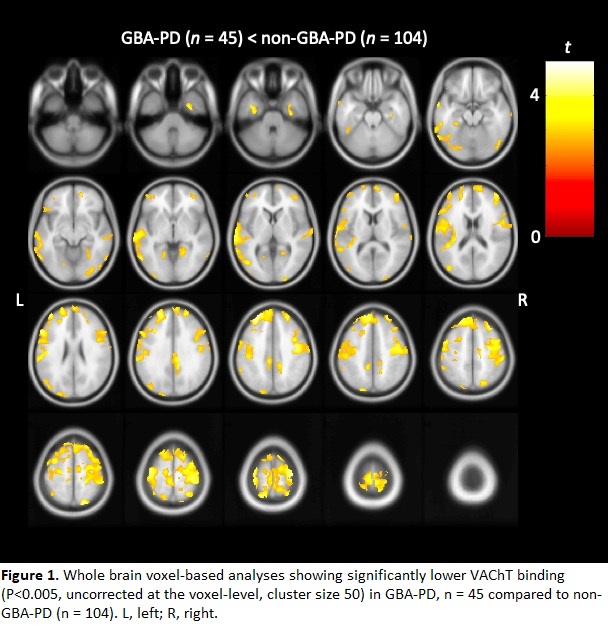Category: Parkinson's Disease: Neuroimaging
Objective: This study aims to characterize the clinical features and cholinergic innervation of early Parkinson’s disease (PD) patients with GBA mutations (GBA-PD).
Background: The GBA-PD phenotype generally is thought to have a worse clinical prognosis with faster disease progression in motor- and non-motor symptoms. Previous work from our group showed that de novo GBA mutation carriers exhibited more extensive posterior cholinergic denervation than PD non-GBA carriers (non-GBA-PD) and controls, which did not have a clinical correlate.[1]
Method: This study included 45 GBA-PD and 104 non-GBA-PD patients as well as 13 healthy controls (HC). Assessments included MDS-UPDRS part II, III and IV, LEDD, a comprehensive neuropsychological examination, Non-Motor Symptom Questionnaire (NMSQ), the Hospital Anxiety and Depression Scale, the REM sleep Behavior Disorder Screening Questionnaire, and the Sniffin’ Sticks test. Cholinergic system integrity was assessed with PET imaging using the tracer [18F]FEOBV. Differences between GBA-PD and non-GBA-PD were assessed using voxel-wise and volume of interest (VOI)-based approaches. Both PD groups were also compared to HC.
Results: GBA-PD ((26 men), mean (SD) age of 68.5(8.1) years (y) and disease duration 4.2 (2.0) y exhibited higher NMSQ and lower mean corrected T-score on executive functioning compared to non-GBA-PD ((82 men), age 66.4 (8.7) y and disease duration 3.6 (1.7) y). Cholinergic voxel-based results revealed an extensive pattern of decreased tracer uptake in GBA-PD, compared to non-GBA-PD [Figure 1]. The VOI comparison closely aligns with our voxel-wise findings including bilateral frontal regions, pre- and postcentral gyri, fusiform gyri, right parahippocampal gyrus and entorhinal cortex and left posterior cingulate exhibited lower DVR values in GBA-PD. Both PD groups showed pronounced lower VAChT binding compared to HC, with the right entorhinal cortex and frontal pole showing significant deficits only in GBA-PD.
Conclusion: Early GBA-PD exhibited a higher burden of non-motor symptoms and lower executive functioning performance than non-GBA-PD. We also observed pronounced cholinergic denervation in this group, compared to non carriers, in the anterior- and central cortical areas, and the limbic regions. This suggest an important role of the cholinergic innervation of these regions in the worse clinical course of GBA-PD.
Figure 1
References: Slingerland, S., van der Zee, S., Carli, G., Slomp, A. C., Boertien, J. M., d’Angremont, E., Bohnen, N. I., Albin, R. L., & van Laar, T. (2023). Cholinergic innervation topography in GBA-associated de novo Parkinson’s disease patients. Brain, awad323. https://doi.org/10.1093/brain/awad323
To cite this abstract in AMA style:
S. Slingerland, S. Zee, G. Carli, A. Slomp, E. D'Angremont, J. Boertien, T. Laar. Early GBA-Related Parkinson’s Disease has a Distinct Clinical Phenotype and Cholinergic Innervation [abstract]. Mov Disord. 2024; 39 (suppl 1). https://www.mdsabstracts.org/abstract/early-gba-related-parkinsons-disease-has-a-distinct-clinical-phenotype-and-cholinergic-innervation/. Accessed April 1, 2025.« Back to 2024 International Congress
MDS Abstracts - https://www.mdsabstracts.org/abstract/early-gba-related-parkinsons-disease-has-a-distinct-clinical-phenotype-and-cholinergic-innervation/

